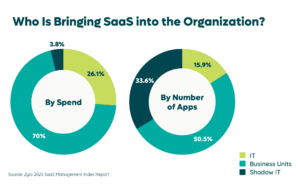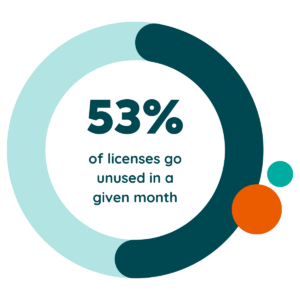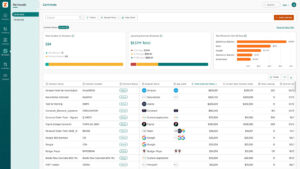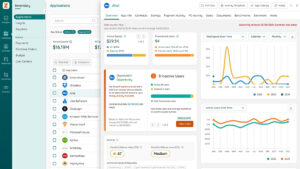Table of Contents
CFOs must be accountable for the financial performance and future of their organizations. This includes allocating capital, forecasting revenue, and understanding investments. But tracking investments becomes murky when it comes to software.
With the ease of SaaS acquisition, app spend often bypasses the traditional procurement process — and becomes decentralized. In fact, Zylo’s 2025 SaaS Management Index shows business units now own 70% of SaaS spend, while individuals are responsible for 4%. That 4% becomes what we call shadow IT, and accounts for nearly half of the applications in an organization.

With software spend typically the second-largest operating expense within a company, behind headcount, CFOs need a purpose-built SaaS Management Platform to optimize this area of spend and minimize financial risk.
Learn how SaaS complicates critical focus areas for a CFO, and how a SaaS Management Platform helps CFOs regain control of SaaS spend.
Challenges for CFOs Created by SaaS
A CFO strives for many financial targets, including predictability, accuracy, value, scalability, and optimization. Learn how SaaS impacts each of these areas.
Visibility and Predictability
CFOs need a line of sight into spend and how it progresses over time in order to manage expenses responsibly and forecast the future. But the decentralization of SaaS makes it difficult to obtain an accurate view of a SaaS portfolio, and its corresponding costs.
To complicate matters further, over half of software purchases aren’t properly categorized as software within expense platforms and other financial systems. With the average organization spending roughly $50M on SaaS annually, this is a problem CFOs can’t afford to ignore.
Accuracy and Control
CFOs should have oversight into how the organization spends its money. To empower better spend management, CFOs and IT asset managers need to work together to create a SaaS spend management strategy.
But with SaaS purchasing spread across the organization, IT now only owns a third of SaaS spend. This makes it hard for CFOs to maintain control and systemize SaaS acquisition.
Value and Efficiency
 On average, organizations only use 47% of their SaaS licenses. The remaining 53% are wasted. Additionally, organizations struggle with duplicative and redundant SaaS technologies in use across the company — and often overpay for those tools.
On average, organizations only use 47% of their SaaS licenses. The remaining 53% are wasted. Additionally, organizations struggle with duplicative and redundant SaaS technologies in use across the company — and often overpay for those tools.
To ensure the company maximizes the value of their SaaS stack and operates efficiently, CFOs need to know what tools they have, their cost, pricing benchmarks, and whether the apps are even being used.
Scalability
Downloading duplicate applications, overpaying on software, and using several apps with redundant functionality throughout an organization are all ways to hinder growth. Beyond the unlocked savings, consider the increased productivity that comes with departments working within the same set of tools. For example, one project management tool to rule them all versus several throughout the organization.
Companies that scale have effective processes in place to maximize efficiency, control costs, and mitigate financial risks.
Optimization
Determining how to best spend money to meet company goals means optimizing every budget, including software. Getting the best deal on SaaS requires real-time utilization metrics and price benchmarking.
In addition, companies should optimize existing apps and their licenses, ensuring maximum utilization of the tools the organization pays for. Complete visibility is required to find unused or underutilized licenses, and eliminate the waste.
How a SaaS Management Platform Helps CFOs
Solve all of the challenges outlined above by using a SaaS management platform to centralize a naturally decentralized category of spend. With powerful automation and rich insights, Zylo guides organizations through a three-step process to regain SaaS control:
1. Gain Visibility
SaaS Management requires full visibility into all applications, but you can’t effectively manage SaaS spend if shadow IT and unknown tools lurk across your organization. The issue only compounds the longer you wait. In fact, Gartner predicts SaaS spend to rise 15 to 20% through 2026, with organizations overspending by 25% or more on SaaS.

To ensure fiscal responsibility, a CFO needs complete visibility into their company’s spending. Zylo’s AI- and ML-powered Discovery Engine uncovers SaaS wherever it lurks with nearly 100% accuracy.
Complete SaaS visibility gives CFOs the ability to:
- Discover wasted spend
- Prioritize spend optimization opportunities
- Empower better spend management
- Forecast and budget with more accuracy
How the Zylo Discovery Engine Powers the Most Comprehensive SaaS Management Platform
Learn More2. Optimize Spending
Once apps are discovered, dig deeper into spend and utilization data to understand the value (or lack of) being derived from applications and where optimization opportunities lie. Zylo data shows many companies waste as much as $18 million on unused SaaS each year. Financial leaders want to save money when possible and see the ROI on current investments. A SaaS Management Platform is just the tool to surface where your most impactful opportunities lie.
Zylo’s App Overview brings spend, usage, and adoption insights together in a single view, so CFOs can find everything they need to make confident decisions around SaaS licenses and renewals.

To automate the process, Zylo Insights surfaces personalized, prioritized, and actionable recommendations to drive rightsizing and savings initiatives.You can instantly trigger workflows to downgrade or deprovision underutilized licenses right from the Insights dashboard.
Guide to Managing SaaS Costs
Learn More3. Implement Governance & Manage Risk
While CFO’s typically don’t focus on cybersecurity, the financial implications of a data breach impact the CFO directly. According to IBM’s Cost of a Data Breach Report, the average cost of a data breach in the U.S. is $4.88M, including mitigation efforts and lost business. Meanwhile, the Gartner® Magic Quadrant™ for SaaS Management Platforms shows companies without a dedicated management tool are 5X more susceptible to a cybersecurity incident.
A lack of ongoing governance also negatively impacts SaaS spend. When employees expense SaaS and bypass IT, you don’t know the terms or security implications, and it becomes impossible to accurately track spend. With six new applications entering the average organization each month, costs quickly grow out of control.

Bottom line: This isn’t a one-and-done approach. Optimizing SaaS spend and use requires continuous monitoring and a SaaS governance framework to build and maintain an efficient and effective tech stack moving forward. Without ongoing discovery, SaaS purchases remain hidden, with up to 30% miscategorized as something other than software or technology, according to Zylo data.
We recommend using an App Catalog and practicing a governance model called Freedom Within a Framework. It allows employees to choose their preferred tools from a pre-vetted list of software curated by IT, and prevents them from expensing applications unbeknownst to Finance.
CFOs: Calm the Chaos of Uncontrolled SaaS Spend
By implementing effective SaaS management, CFOs calm the chaos of uncontrolled SaaS and get their books back in order — allowing them to scale and grow their businesses while forecasting for the future.
Want to learn more about how Zylo’s helps CFOs take control of their SaaS spend? Request a demo today!


